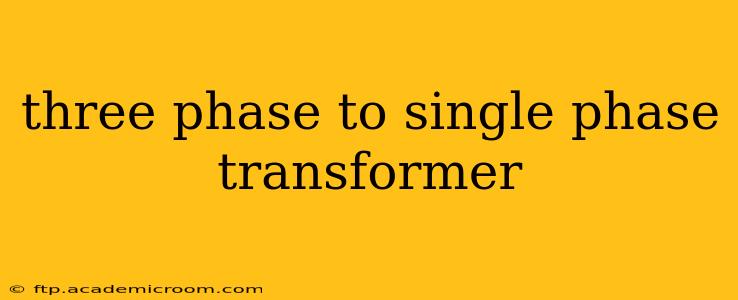Three-phase to single-phase transformers are essential components in power distribution systems, enabling the conversion of three-phase power (commonly found in industrial settings and high-voltage transmission lines) to single-phase power (used in most homes and smaller businesses). Understanding their function, applications, and different connection methods is crucial for anyone working with electrical power systems. This guide delves into the intricacies of these transformers, addressing common questions and providing valuable insights.
What is a Three-Phase to Single-Phase Transformer?
A three-phase to single-phase transformer is a static device that converts three-phase alternating current (AC) power to single-phase AC power. It achieves this by utilizing different winding configurations on the primary (three-phase) and secondary (single-phase) sides. The core principle involves selectively tapping into the three-phase supply to create a single-phase output. This conversion is necessary because many loads and appliances operate on single-phase power, even within a three-phase power distribution system.
How Does a Three-Phase to Single-Phase Transformer Work?
The operation relies on the vector sum of the three-phase voltages. Depending on the connection method (Scott-T, open-delta, or others), the transformer windings are strategically arranged to extract a single-phase voltage from the three-phase source. This extracted voltage is then stepped up or down, depending on the transformer's turns ratio, to provide the desired single-phase output voltage. The exact method used impacts the voltage balance and efficiency of the single-phase output. Careful design is necessary to minimize harmonics and voltage imbalances.
What are the Different Types of Three-Phase to Single-Phase Transformer Connections?
Several connection methods exist, each with its own advantages and disadvantages:
1. Scott-T Connection:
This is a popular and efficient method. It uses two transformers: one is a main transformer connected across two phases of the three-phase supply, and the other is an auxiliary transformer connected to one phase and the midpoint of the main transformer. This combination produces two single-phase outputs, typically 90 degrees out of phase.
2. Open-Delta Connection:
This method utilizes two transformers connected in an open-delta configuration. While simpler than the Scott-T, it's less efficient and produces a slightly unbalanced single-phase output. It's often used as a temporary or backup solution.
3. Other Methods:
Less common configurations exist, often tailored to specific applications or voltage requirements. These might involve specialized winding arrangements or the use of multiple transformers in more complex configurations.
What are the Applications of Three-Phase to Single-Phase Transformers?
These transformers find wide application across various sectors:
- Residential Areas: Supplying single-phase power to homes and buildings within a larger three-phase distribution network.
- Industrial Settings: Powering single-phase equipment within a predominantly three-phase environment.
- Rural Electrification: Extending single-phase power to areas where three-phase infrastructure might not be readily available.
- Power Factor Correction: Improving power factor in single-phase circuits.
What are the Advantages and Disadvantages of Using Three-Phase to Single-Phase Transformers?
Advantages:
- Efficient Power Conversion: Provides a reliable method for converting three-phase to single-phase power.
- Cost-Effective: Generally more economical than other methods for supplying single-phase loads from a three-phase source.
- Wide Applicability: Suitable for various applications, from residential to industrial settings.
Disadvantages:
- Complexity: Some connection methods (like the Scott-T) can be more complex to configure and maintain.
- Potential for Imbalance: Improper design or connection can lead to voltage imbalances in the single-phase output.
- Harmonics: Depending on the load and connection, harmonic distortion might be introduced into the single-phase output.
How to Select a Three-Phase to Single-Phase Transformer?
Selecting the appropriate transformer requires careful consideration of several factors:
- Input Voltage: The three-phase voltage of the supply.
- Output Voltage: The required single-phase voltage.
- Power Rating (kVA): The total power the transformer needs to handle.
- Connection Method: The specific configuration required for the application.
- Efficiency and Harmonics: The desired level of efficiency and the acceptable level of harmonic distortion.
This comprehensive guide provides a solid understanding of three-phase to single-phase transformers. Remember to consult with qualified electrical engineers for any specific applications or installations to ensure safe and efficient operation.
